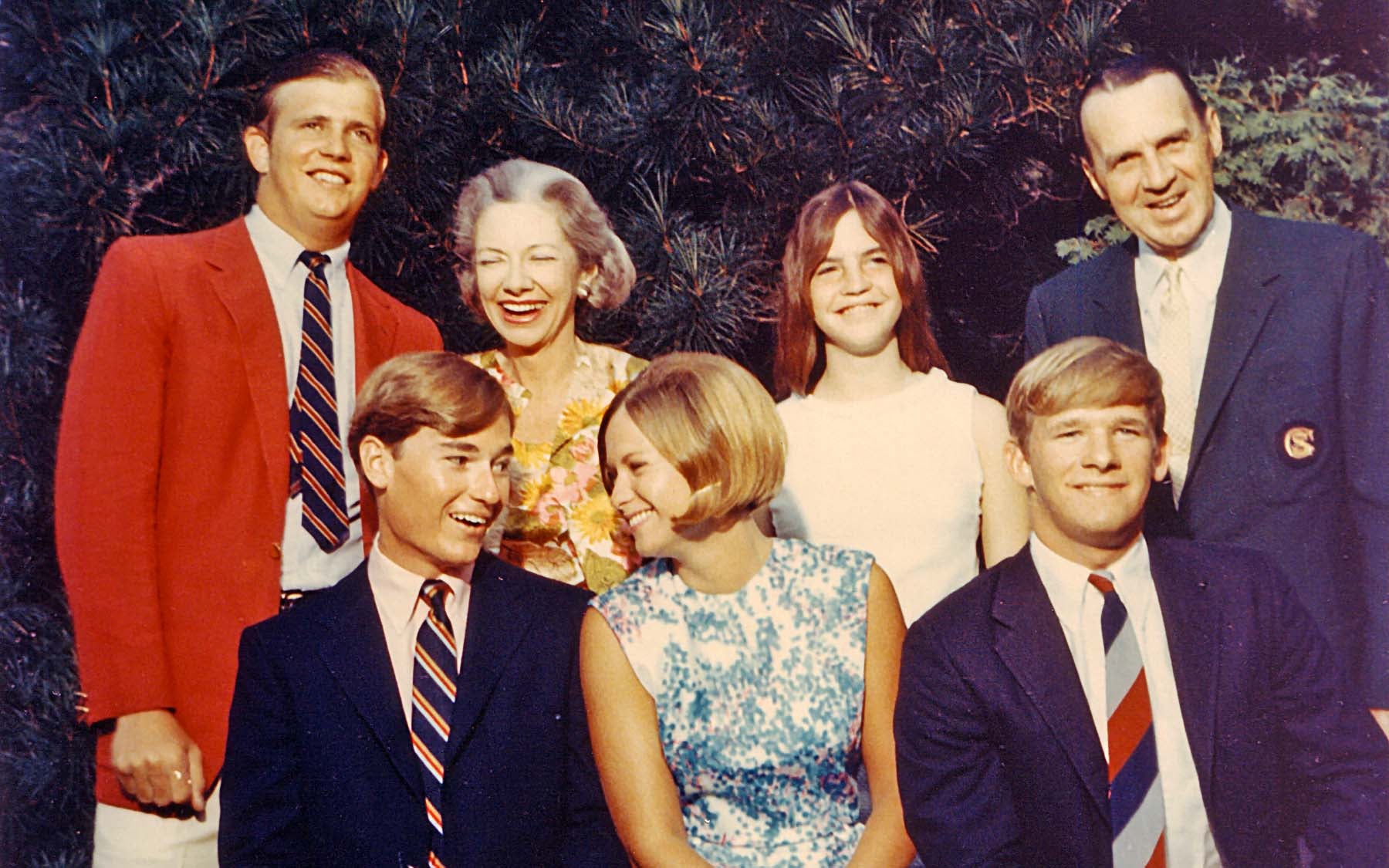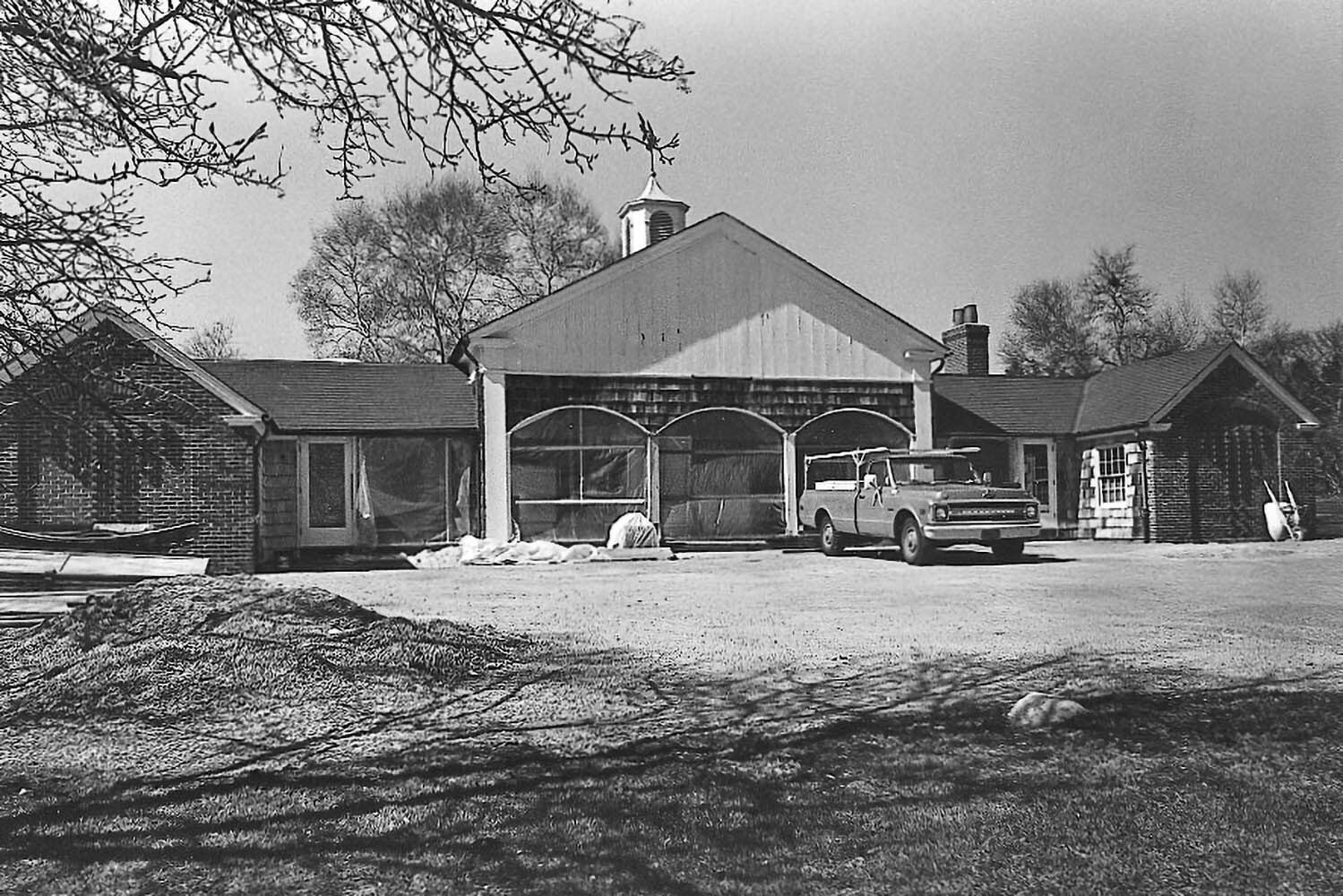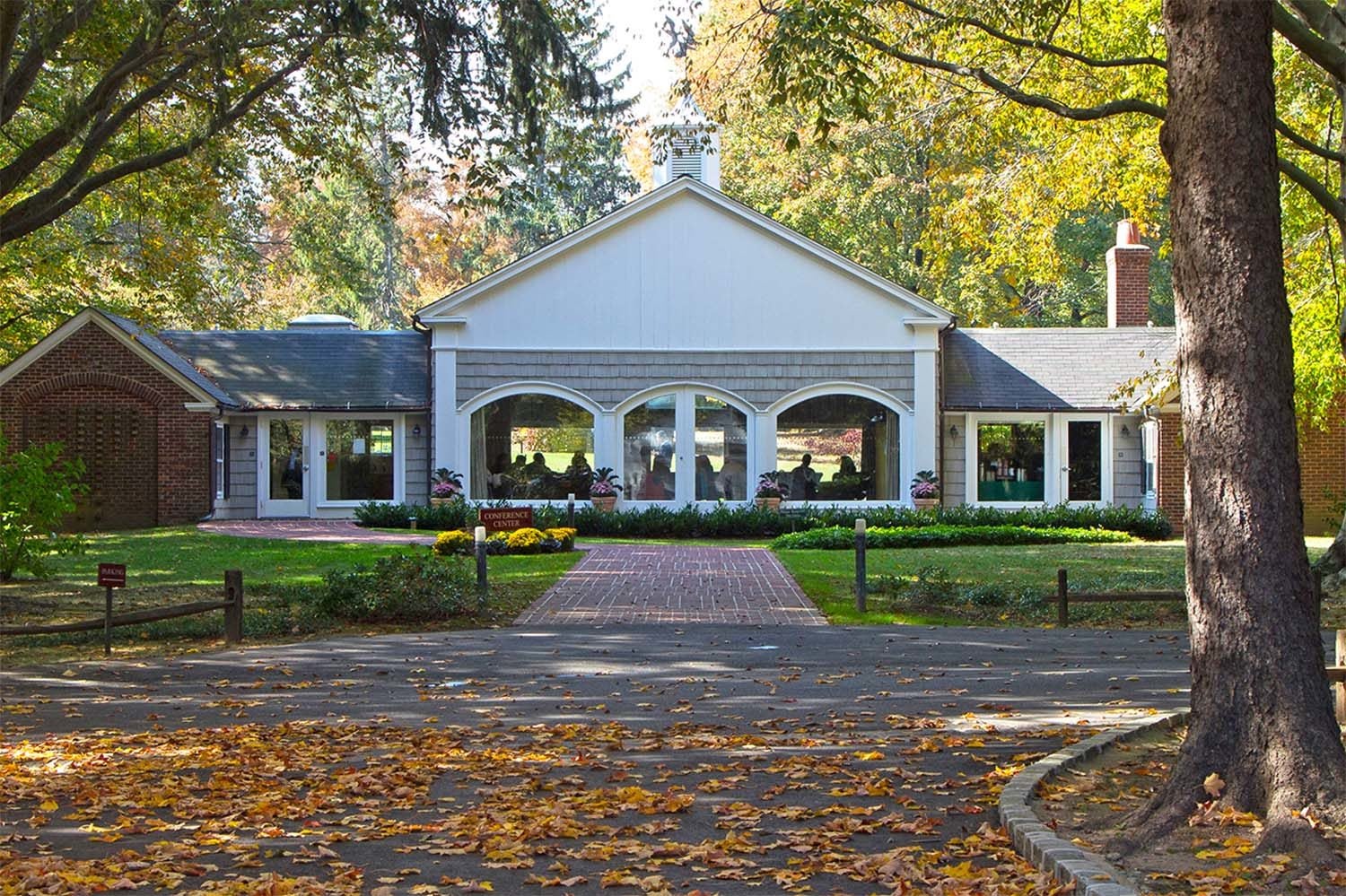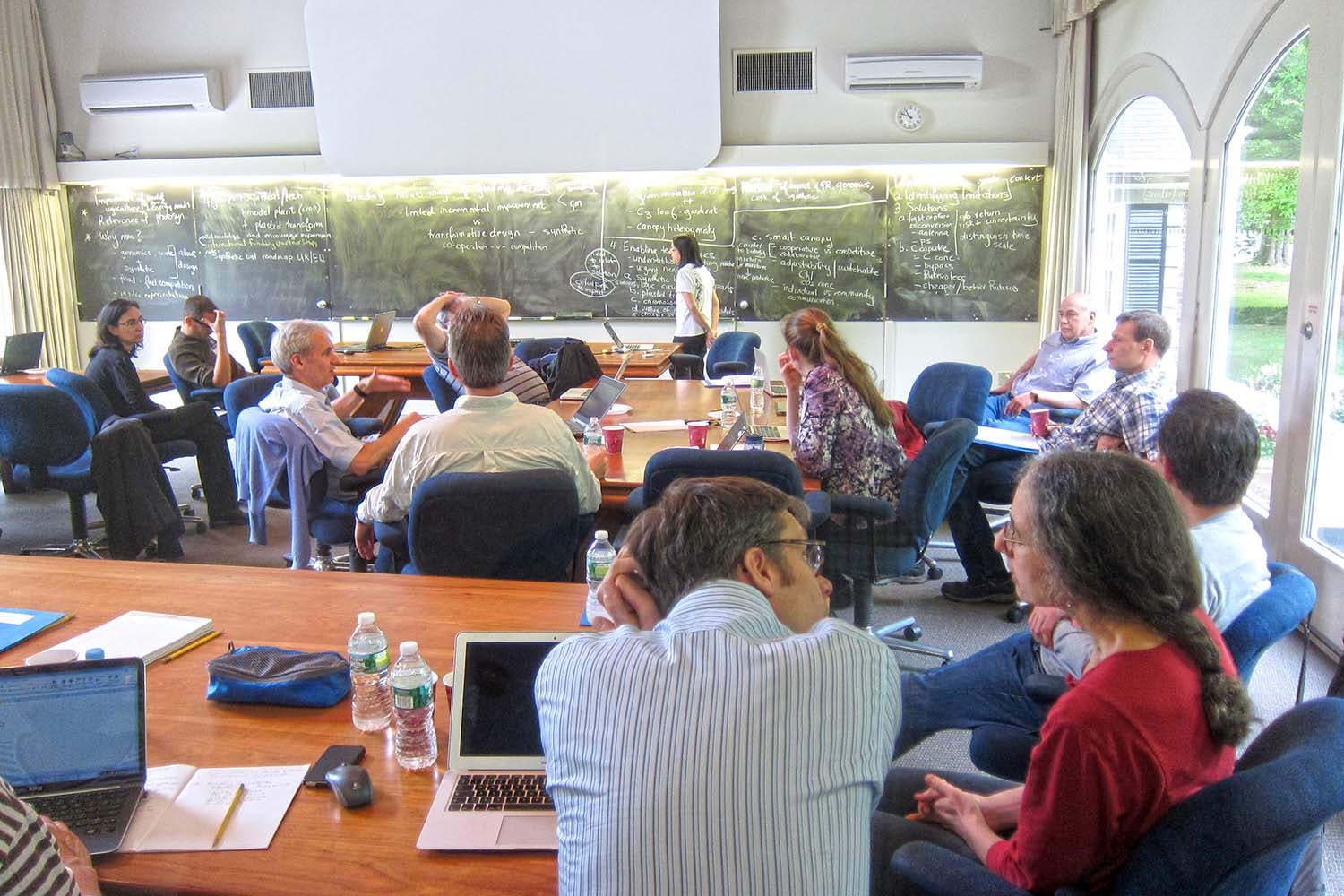Jim Watson wrote in his 1968 Annual Report, his first as director of Cold Spring Harbor Laboratory:
“The Lab badly needs a real benefactor… Of course, I dream an angel will appear soon and make me free of any serious [financial] worries for at least a month.”
He had reason to worry, for Cold Spring Harbor Laboratory (CSHL) had been on the verge of bankruptcy for the previous 10 years. The angel did appear, in 1972, in the guise of Charles Sammis Robertson who lived in Lloyd Harbor, some five miles from the Laboratory. The Robertson family gifts to CSHL in the early 1970s were of extraordinary importance, for without them the Laboratory might not have survived.
The Robertson family
Charles Sammis Robertson was a Sammis through his mother’s family. John Sammis began farming on the west side of Huntington Harbor in about 1660, and through shrewd investments and expansion into other activities such as grist milling, brick making, and banking, John’s descendants prospered and multiplied. An 1873 map of Lloyd Harbor shows properties belonging to no fewer than eight Sammises with the initials E, HE, JF, L, P, R, WA, and WB.
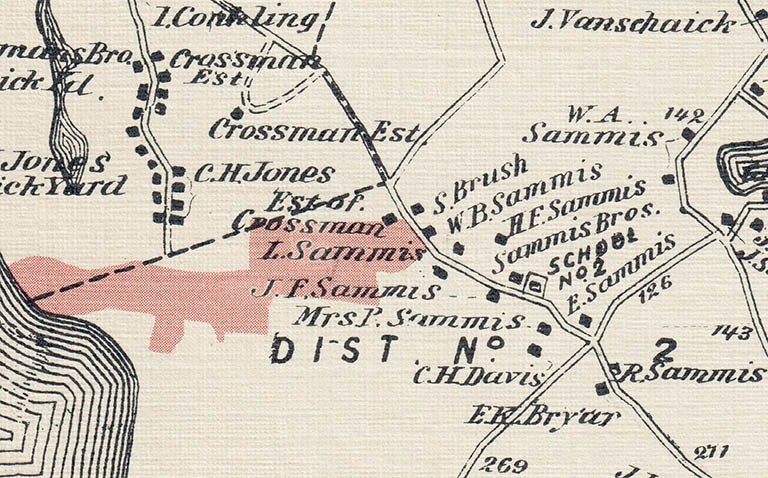
Born on February 13, 1905, Robertson graduated magna cum laude from Princeton University in 1926 and returned to the Huntington area to look for work. This was not easy in the latter part of the 1920s with The Depression approaching, and Robertson took a job in the local realtor’s office. One day, a lady came into the office looking to buy property in the area. This was Marie Hoffman, a member of the Hartford family which owned the Great Atlantic and Pacific Tea Company, later known as A&P.
At the time Marie and Charles met, she was one of the wealthiest women in the USA. Marie was a granddaughter of George Huntington Hartford, one of the founders of A&P, which in 1951 was the largest retailer in the USA. A trust fund had been established for the five children of George. When the trust was dissolved and the A&P stock distributed among George’s grandchildren, Marie and her sister each received 10% of the stock worth $100 million, the equivalent of $473 million in 2019.
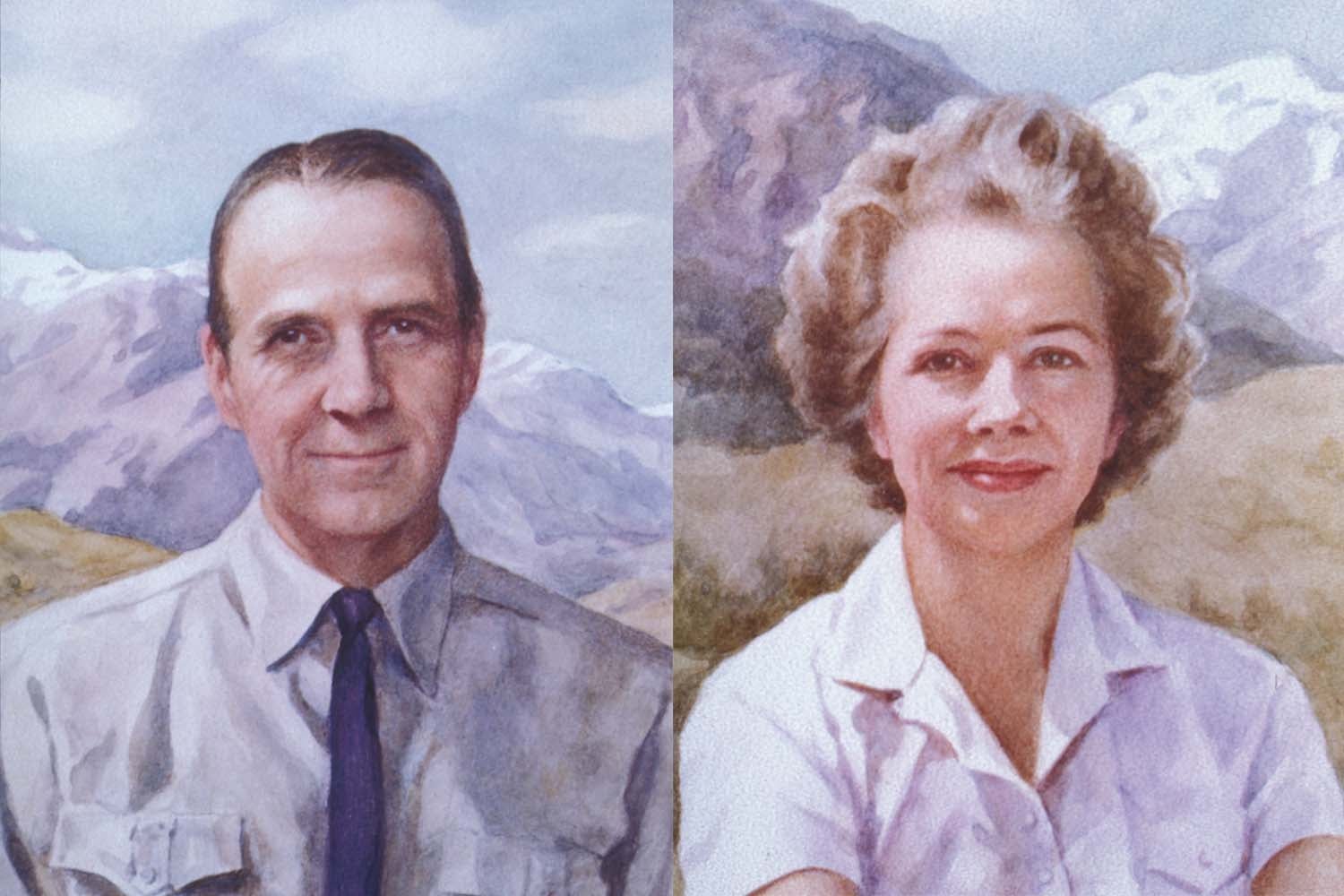
Marie and Robertson married in 1936. Together they began to purchase land in Lloyd Harbor, properties that had been, and in some cases still were, owned by the Sammis family. The land eventually totaled some 50 acres, stretching west from West Neck Road, along a then-unnamed private road, and down the steep bluffs to a beach on Cold Spring Harbor. At the western end of the property, on the edge of the bluffs, they built a gracious home, designed by the notable architect Mott B. Schmidt, who also built the New York townhouse of Mrs. William K. Vanderbilt in Sutton Place. There was an elegant garage and a spectacular outdoor swimming pool perched halfway down the bluffs with wonderful views west to Oyster Bay and Center Island, and north across Long Island Sound to Connecticut. There the Robertsons brought up their four children, John, Bill, Anne, and Kate.
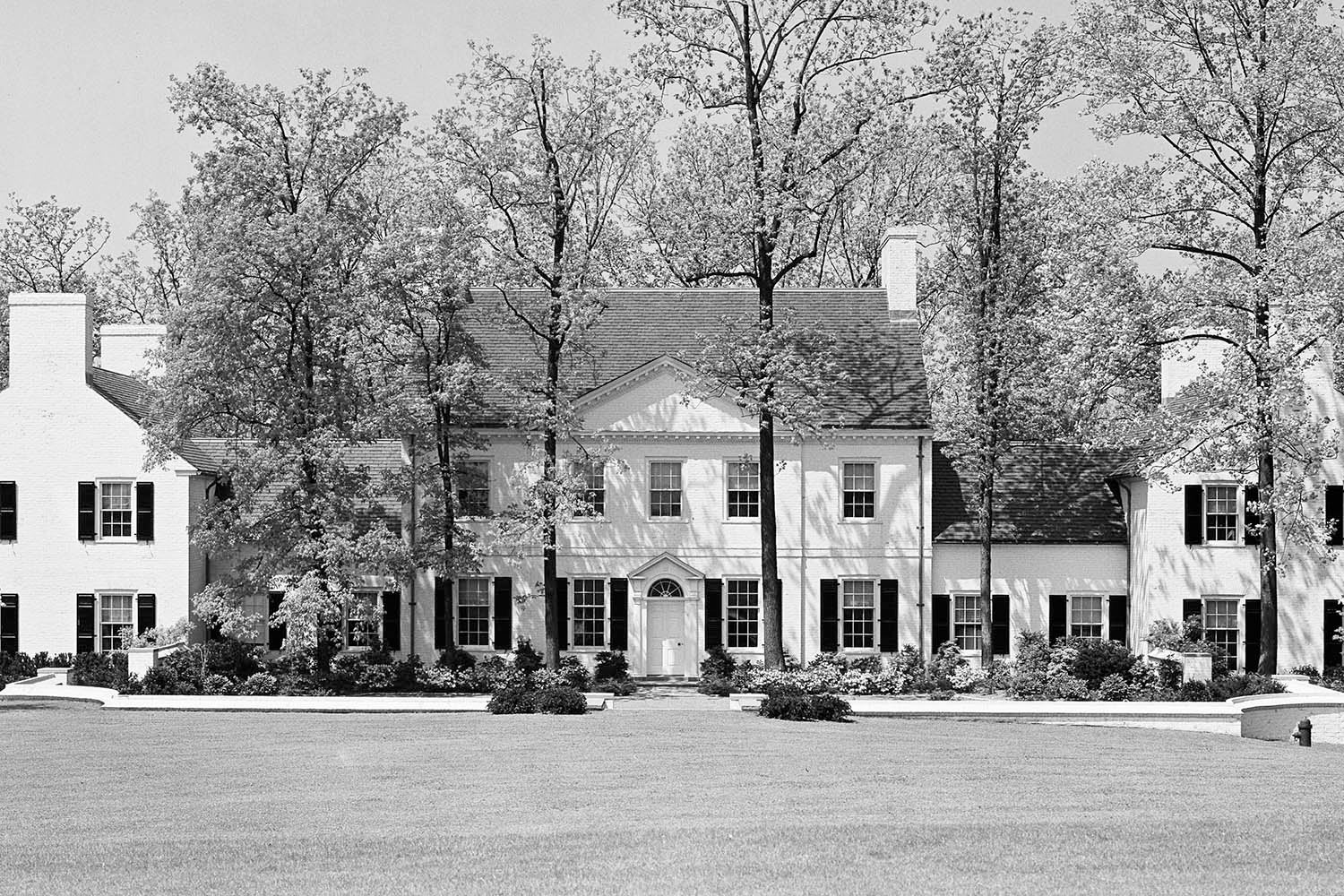
The Robertson’s philanthropy
Charlie and Marie were generous in their use of the family fortune. Robertson’s philanthropic strategy was clear, as he wrote to his children in January 1973: “Personally I do not favor what is called ‘scatteration’—where a foundation divides its annual income among a hundred or more most deserving agencies and institutions.” Instead, he and Marie chose to give large amounts of funding to a few institutions: “We strive for excellence and for the concentration of resources, hoping to win the big prize…”
In keeping with their characters, they chose to carry out their philanthropy quietly, not desiring the self-aggrandizement that seems to motivate many such gifts; a later newspaper report referred to Charles as a “reclusive” philanthropist. The largest gift, of $35 million, was made anonymously in 1962 to Robertson’s alma mater, Princeton University, and was used to endow the Woodrow Wilson School of Public and International Affairs. (The anonymity was broken during the campus turmoil of the Vietnam War years. Princeton students could not believe that a private individual would give such a large donation and wish to remain anonymous. The President of Princeton prevailed on the Robertsons to reveal that it was they, and not the CIA, who had provided the funds.)
Marie died tragically in 1972, and Robertson’s thoughts turned to making further philanthropic gifts. There was also the question of what should be done with their home. Turning the property over to developers and having “…the bulldozers take over…wouldn’t make sound [financial] sense.” Instead, Robertson proposed making a gift of the entire estate to an organization that would use the estate for purposes that interested him. Robertson later wrote that the Laboratory was “right at our front door and has been a vital part of our community for over eighty years”—it was the logical and appropriate choice.
Cold Spring Harbor Laboratory
Some background on the financial state of CSHL in the 1960s is needed to fully appreciate the importance of Robertsons’ philanthropy to the Laboratory.
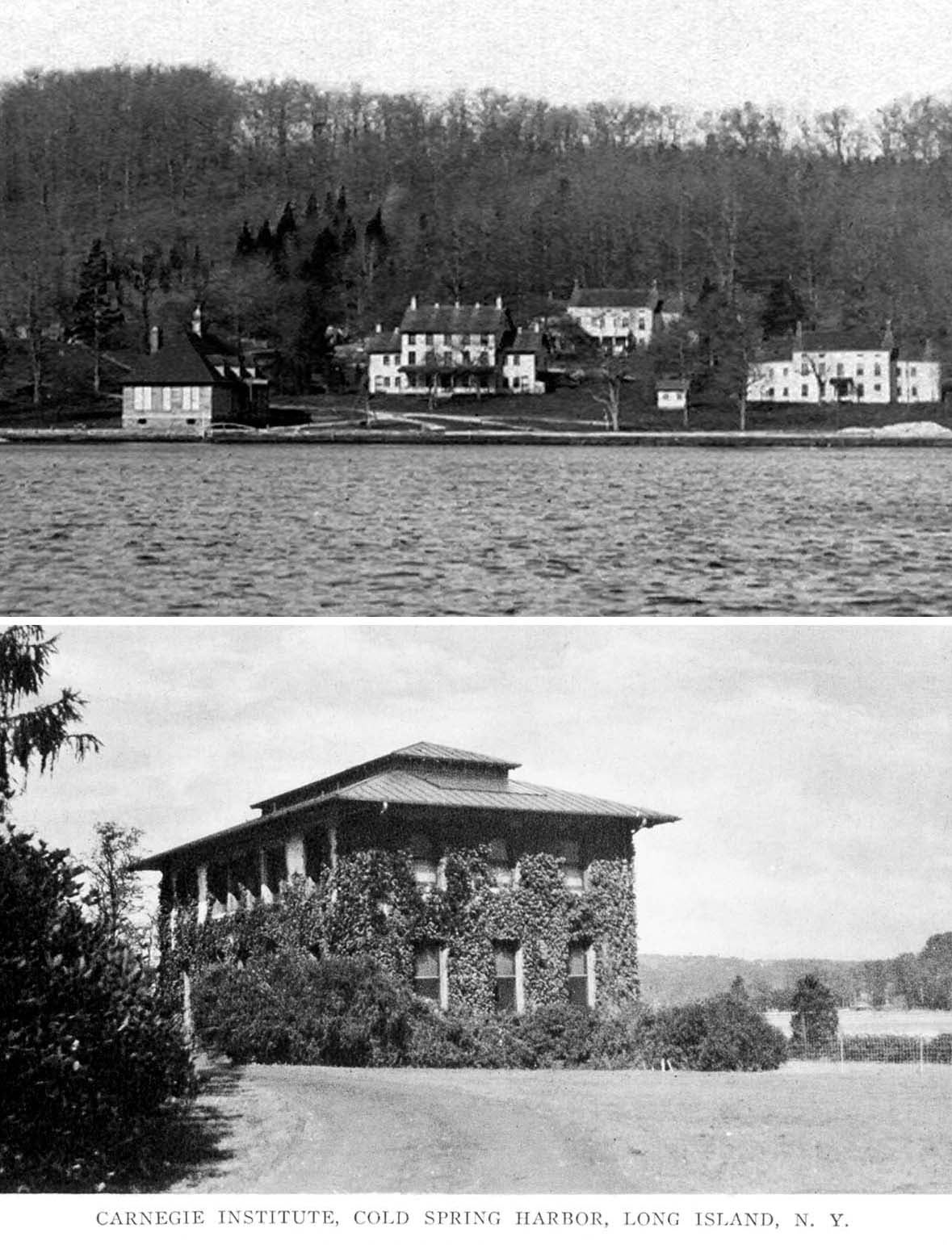
The first laboratory at Cold Spring Harbor was built on the southwest shore of the harbor in 1890 by the Brooklyn Institute of Arts and Sciences. The Long Island Biological Association (LIBA) took over that lab in 1924. In 1904, the Carnegie Institution of Washington founded the Station for Experimental Evolution, focusing on genetics research. However, while the Department of Genetics was well-funded by Carnegie, the Biological Laboratory, dependent on gifts from members of LIBA, was always struggling financially.
Matters came to a head in the late 1950s when the Carnegie Institution decided that the Department of Genetics should be closed. A new entity—the Cold Spring Harbor Laboratory for Quantitative Biology—was formed by the merger of the Biological Laboratory with the remaining CIW assets at Cold Spring Harbor, and John Cairns became director in 1962.
Simply creating a new institute did not help the financial situation, and Cairns immediately found that the Laboratory was in dire straits. He spent his directorship trying to prevent its collapse and he largely succeeded, but by 1966 he was tired and wanted to return to research. Watson was on the CSHL Board of Trustees and drew up a plan of what he thought should be done. He cannot have been altogether surprised when the Trustees proposed that he should take on the job, and in 1968 he did so.
Simply appointing a new director did not solve the financial difficulties, although some relief was forthcoming through efforts of Joe Sambrook, Watson’s first appointment. Sambrook wrote a successful grant application to the National Cancer Institute for research on tumor viruses, and there was further relief in 1972 when the Laboratory became an NCI Cancer Research Center. However, even as Watson welcomed the NCI grant in his 1972 annual report, he was still sounding a note of caution: “Prudence suggests that we must find some stable private funds as a cushion to unpredictable fluctuations in federal support.” It was now that Jim’s angel appeared.
The Robertson gifts: Promoting research
In June 1972, Jim and Liz were on vacation at Sea Ranch in Florida when Watson received a phone call from Ed Pulling, chairman of LIBA. Pulling told Watson that a Charles Robertson had been in touch, asking to visit the Laboratory with a view to making a donation. A tour of the Laboratory was hastily set up for Robertson and Eugene Goodwillie, his financial advisor, which was followed by lunch, cooked by Liz. It was, Watson later said, the “most important lunch ever held at the Lab.” On September 26, 1972, Robertson reciprocated with a dinner for Watson, Ray Gesteland and Robert Pollack (Research Scientists) and Bill Udry (Administrative Director) at the Lloyd Harbor House. That evening, Robertson wrote to Watson:
“It was nice of you and your associates to subject yourselves to the cross-questioning following dinner at our home the other night. You may rest assured that we all found your observation of genuine interest to us and really have a much clearer idea of the purpose and objective of the Laboratory. The meeting, therefore, as far as we were concerned, was a success.”
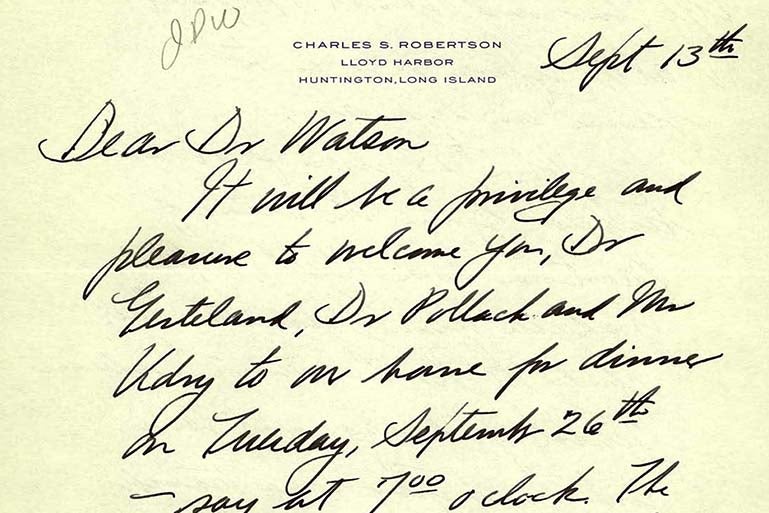
As a result, discussions began about the Robertson family, through its foundation, the Banbury Fund, providing a substantial gift for the CSHL endowment and also conveying the Lloyd Harbor estate to the Laboratory.
It was decided that the gift would be administered by a new entity, the Robertson Research Fund (RRF), but it was some while before the funds were transferred to CSHL. A key element in the discussions concerned the IRS and whether it would recognize the RRF as a public charity by virtue of the fact that it existed solely in relation to CSHL, rather than a private charity that would incur severe penalties and taxes. By May 1973, the matter was settled when the IRS declared that the RRF was a 501(c)(3) entity. The RRF was to be administered by a board of nine, five representatives of the Laboratory and four for the Robertson family (table 1; table 2 lists the trustees 1973–2018).
Annual reports would be submitted to the Board and one or more scientists would describe how the RRF had helped them in their research. In addition, Charles joined the CSHL Board of Trustees (1974–1976), to be followed by William Robertson (1977–2018) and now Geoffrey Robertson, Bill’s son (2019–present).
On May 21, 1973, Charles Robertson wrote a note marking the establishment of the RRF, enabling the gift to be made to Laboratory. And the gift? It was in the undreamt amount of $8.5 million, at a time when the total assets of the Laboratory were $2.8 million!
The Robertson family’s gift could not have been more timely because an emergency arose later in 1973. Arthur Knutson, the owner of the marina on the eastern shore of the inner harbor, opposite the Laboratory, announced plans to greatly expand the marina. This would have destroyed the calm of the inner harbor as well as causing great environmental damage. He offered to sell the marina to CSHL and the RRF board agreed that the income from the first year of the RRF could be used to purchase the marina, thus averting what would have been a disaster for the Laboratory.
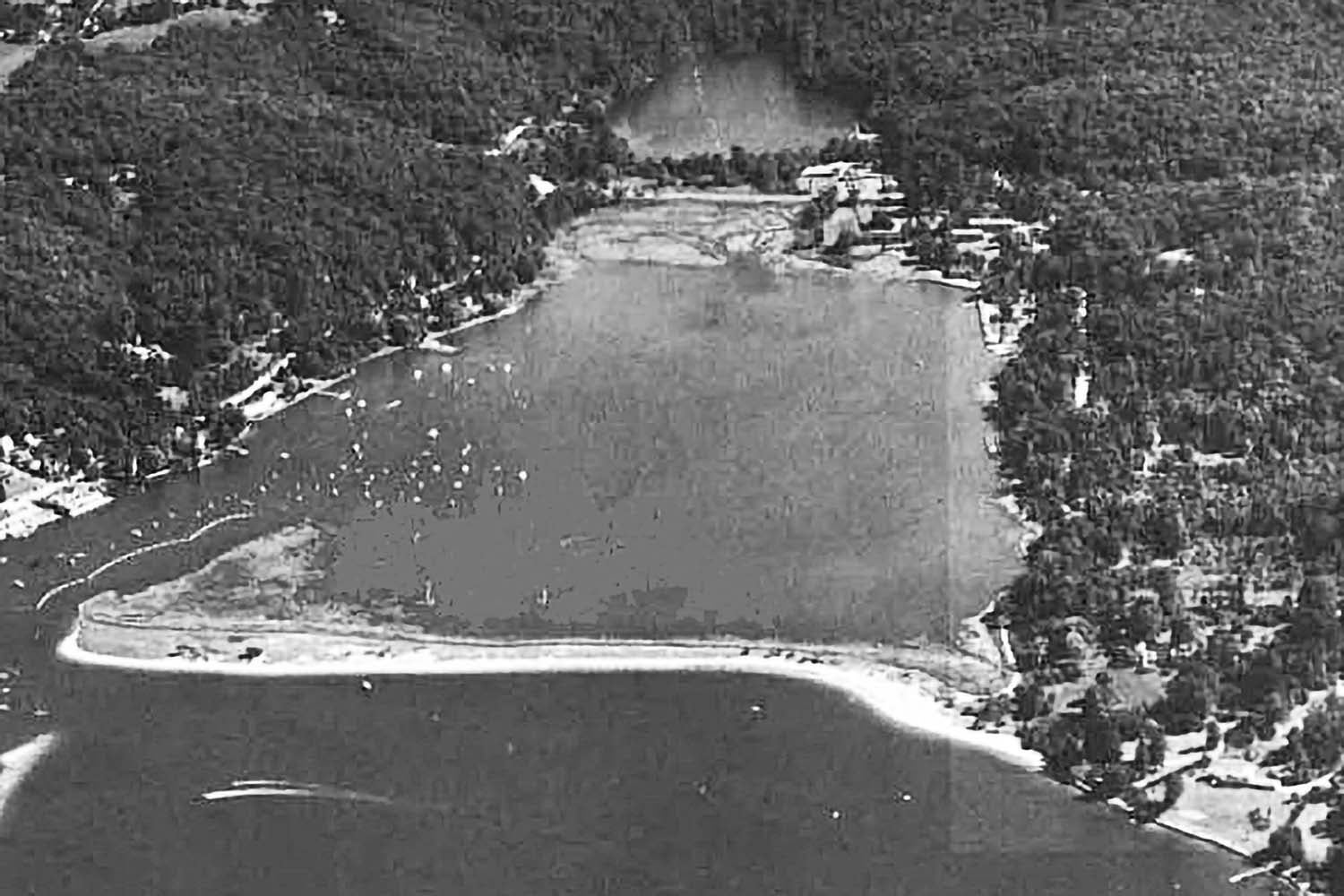
The impact of Robertson’s gift was immediate, providing a much needed $155,000 that was used to purchase equipment for the newly completed annex to James laboratory, as well as to support research on the SV40 tumor virus. Evidence of the Laboratory’s desperate need for this funding was clear. In 1974, the first full year of the Fund, it provided an income of $320,000, an extraordinary 21% of the Laboratory’s research expenses that year! The funding was used to purchase new and urgently needed equipment for the Demerec, James and Davenport laboratories. Since 1974, the Fund has grown to $105 million (2019) and has provided an average of 3.5% of the Laboratory’s total expenses and 8% of research expenses over the life of the Fund, the rise and fall of the drawdown paralleling the changes in the economy and the level of federal funding.
In his July 23, 1973, letter to members of the Long Island Biological Association, which raises funds for Cold Spring Harbor Laboratory, Ed Pulling, its Chairman, listed the areas to be supported by the RRF:
- Stipends for visiting research scientists who come to Cold Spring Harbor for intervals of several months to several years.
- Scholarships for participants in the Laboratory’s several summer programs aimed at training in the fundamental sciences related to cancer research.
- Funds for the initiation of a year-round program of specialized meetings in the area of biomedical research.
- Funds for the Laboratory’s program of summer courses, workshops, and research in the area of neurobiology.
- Funds for the support of a permanent staff in the general area of molecular biology and cancer research.
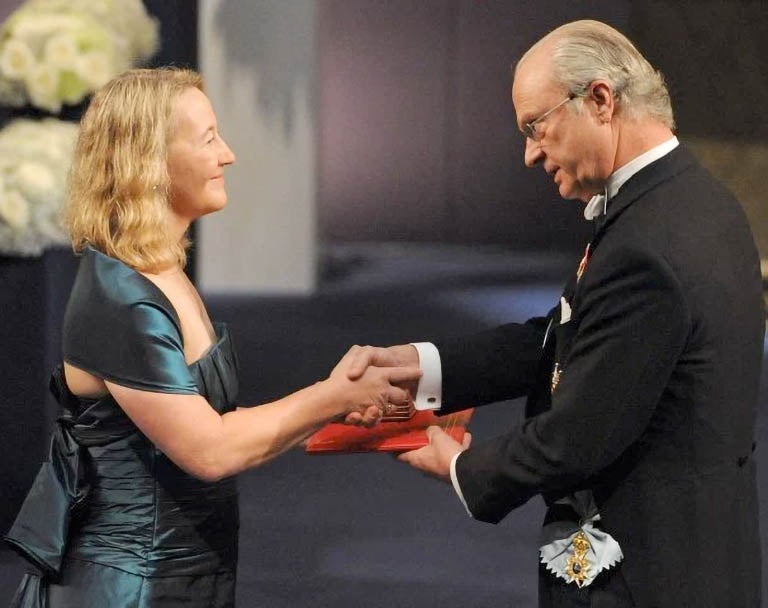
These five points have been followed throughout the life of the RRF. In recent years support has been provided for cancer and molecular biology research, and also includes support for Neuroscience and Plant Biology faculty. Support for research training continues to be an important component. For example, while pre and postdocs may have successfully competed for and secured their own funding, it may fall short of what is needed; the RRF can fill that gap. The RRF also supports the CSHL Postdoctoral Office of Education. This provides essential guidance for our new scientists, assisting them in their careers and guiding them in the transition to research independence or other scientific careers.
The importance of RRF support for young scientists is demonstrated by the careers of Adrian Krainer and Carol Greider. Both received RRF monies when they came to Cold Spring Harbor as CSHL Fellows. Adrian has developed a treatment for a fatal childhood disorder and was awarded a Breakthrough Prize. Carol made fundamental discoveries in genetics for which she was awarded the Nobel Prize in Physiology or Medicine.
The Robertson gifts: Promoting research worldwide
The creation of the RRF did not end the Robertson family’s contributions to CSHL. In January 1973, Robertson wrote to Watson of his hope “…to add the family homestead in Lloyd Harbor as an integral part, one day, of your program.” In early June 1973, matters were sufficiently far advanced that Bill Udry, the CSHL Administrative Director, sent a letter to Robertson assuring him that the property would be used solely to further the Laboratory’s work and that it would not be subdivided. Later in June, the Trustees passed a resolution that, should Robertson choose to grant the lands to the Laboratory under these conditions, it would accept them.
The initial gift consisted of the 41-acre estate and all the buildings on it, together with a $1.5 million endowment for the Robertson Maintenance Fund, now $16.7 million (2019). It is likely that the gift of the Maintenance Fund was a significant factor in the CSHL Trustees’ decision to accept the estate. Institutes are given buildings and property but these can be an unwelcome burden without the means to pay for their upkeep. In this case, Robertson’s foresight in endowing the Maintenance Fund meant that CSHL was relieved of this burden, the income from the endowment covering the upkeep of the estate. Furthermore, a grant of protective Conservation Easements to the Nature Conservancy ensured that the ecology, beauty and natural resources of the estate would be preserved.
Exactly what the Laboratory would do with the estate was undecided. In December 1972, Robertson had written to Watson of his interest in neurobiology, suggesting that CSHL might consider a “modest research program in this area” and that it might be “located on our property.” Presumably, Watson persuaded that even a modest program would be prohibitively expensive and that the Village of Lloyd Harbor was unlikely to permit the construction of laboratories within borders.
Instead, Watson drew on his experiences of the CIBA Foundation Symposia in London that he and Francis Crick had attended in the 1950s and 60s. These were intense discussion meetings for 24 invited participants on topics in biomedical science. Watson proposed that the Banbury estate garage be converted into a conference room and that the family house be modified to accommodate the participants. Robertson agreed and an important step was taken on August 16, 1976, when the Village of Lloyd Harbor granted the Laboratory’s application for a special use permit for the Banbury estate “…as an educational conference center for high-level scientific seminars limited to the exchange of technical information among specialists in the fields of study conducted at the Cold Spring Harbor Laboratory.”

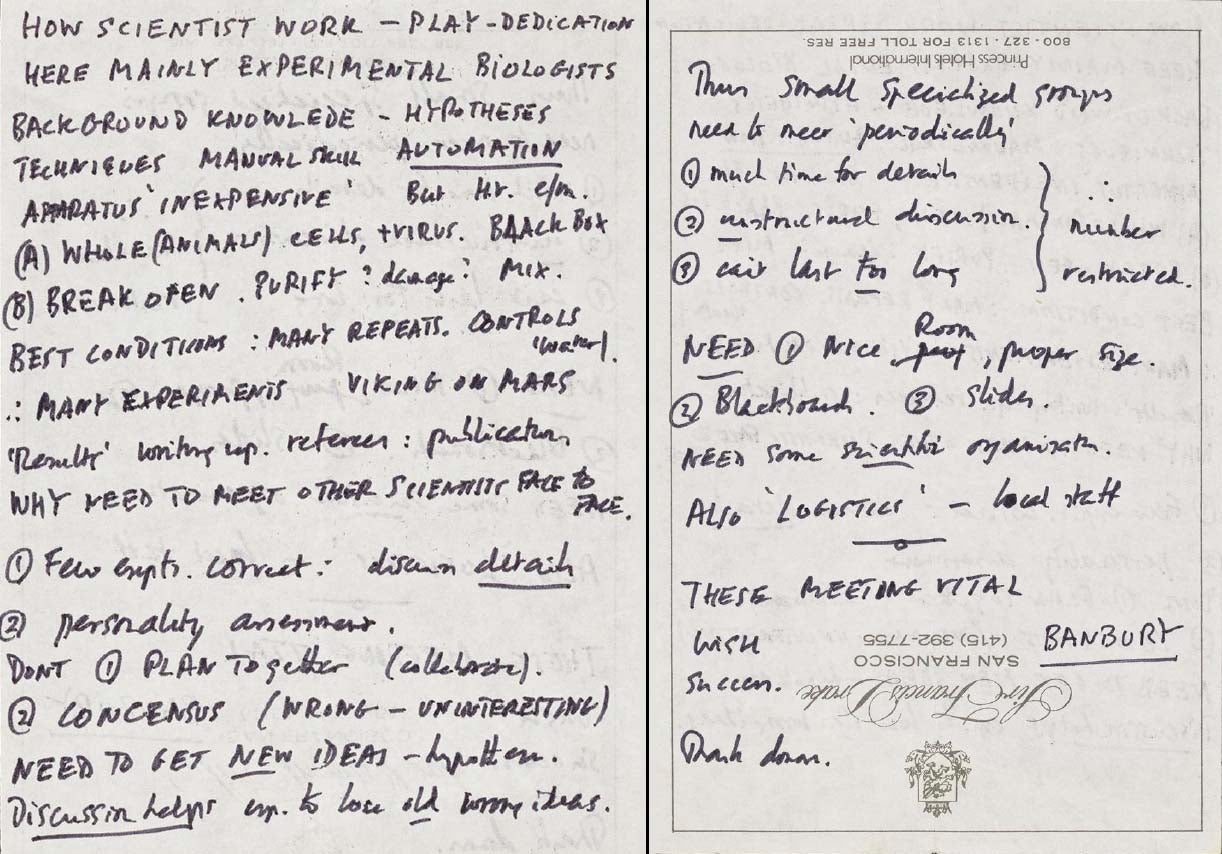
Robertson provided $100,000 to carry out the necessary modifications, creating an extraordinary seminar room. The Banbury Center was formally dedicated on Sunday, June 12, 1976, when Francis Crick gave a talk on “How Scientists Work.” He described why it was necessary for scientists to meet face-to-face: few experiments are correct so details need to be examined, and there is a need to have the opportunity to make personality assessments. The way to do this is by having small, specialized meetings that have much time for details, unstructured discussion, that don’t last too long, are held in a nice room of the proper size, with a blackboard and slide projection, and the staff to organize them. He ends: “These meeting (sic) vital.” In short, he described what the Banbury Center was and how it works!
What topics should be the focus of Banbury meetings? One of the pressing issues of the 1970s was the health risk of environmental pollution, highlighted by the notorious Love Canal in Niagara, New York. Watson believed that a program of Banbury meetings on cancer and environmental hazards would make an important contribution to this highly controversial area where science and public policy interacted. Thus the first Banbury meeting, held on May 1978, was on “Assessing Chemical Mutagens.” Unfortunately, the National Cancer Institute was not interested in funding these meetings and fortunately the range of topics rapidly broadened to include the whole of biological research and science policy.
The Robertson family contributions to the Banbury Center continued in the following years. The number of participants in the meetings exceeded the accommodation available in the family house, now called Robertson House; participants had to be driven to the main campus. In 1981, the RRF joined with the Max C. Fleischman and Kresge Foundations to cover the costs of building of Sammis Hall, a guest house that houses 16 participants. And some years later, the RRF enabled the purchase of the Meier House so that at last all participants could have single rooms.
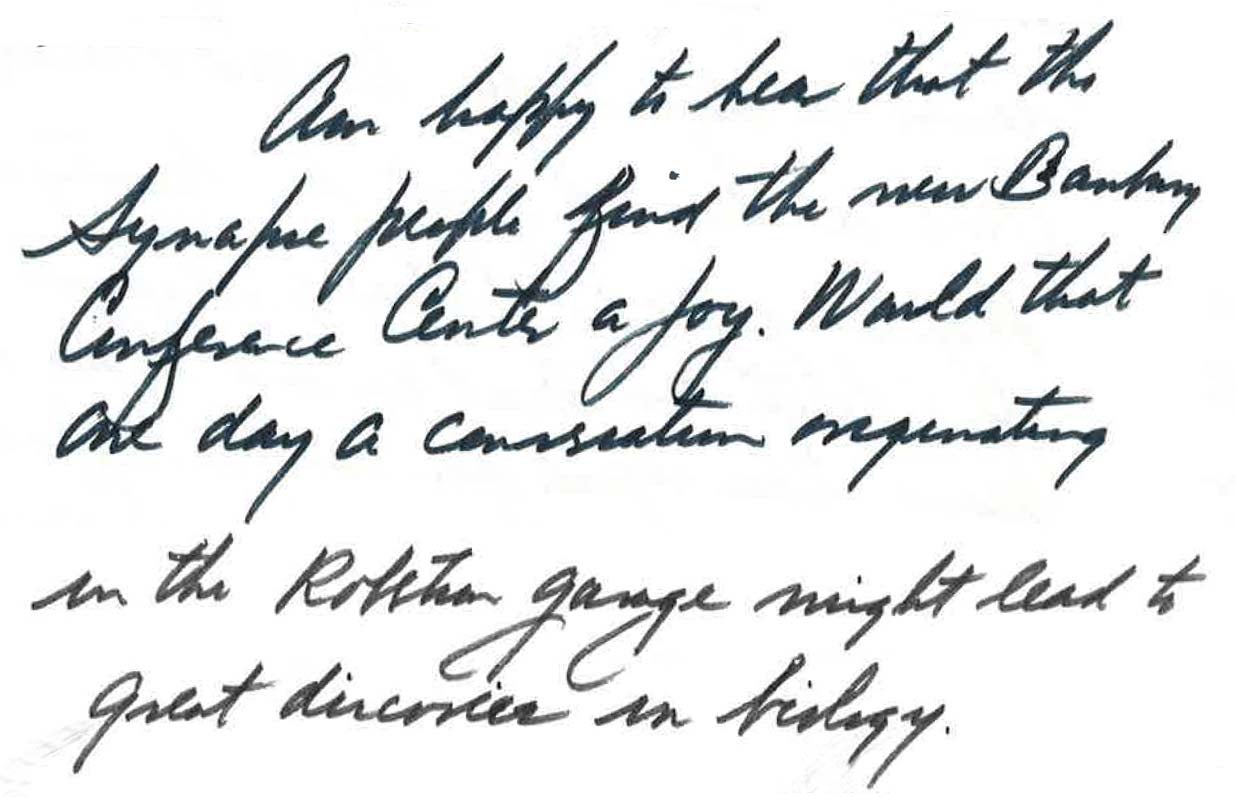
From the beginning, the Center was judged a success by scientists, so much so that Watson could headline a section of his 1979 annual report: “The Banbury Meeting House draws nothing but raves.” The Center very rapidly became recognized as the premier venue for intensive discussion meetings, stimulating research in new areas or examining where research in established fields might go next. Banbury has held over 600 meetings attended by over 12,500 scientists, including 76 Nobel laureates, 700 members of the National Academy of Science or Medicine, and 156 Fellows of the Royal Society.
Robertson had written to Watson: “Would that one day a conversation originating in the Robertson garage might lead to great discoveries in biology.” There have indeed been many conversations at Banbury meetings that, while perhaps not leading to great discoveries, have spurred research and led to advances in many areas of biology (table 2). The Center is not afraid of venturing into science policy, and frequently tackling controversial topics. The meeting that epitomized the relation between science and public applications was that on DNA Technology and Forensic Science, which encouraged Peter Neufeld and Barry Scheck to establish the Innocence Project. Neufeld wrote:
“The Banbury Center’s meeting on “DNA Technology and Forensic Science” in the late 1980s was not only the watershed moment for the implementation of DNA testing in America’s criminal justice system, but also provided a blueprint for assessing the validity and reliability of all forensic disciplines over the last twenty-five years.”
The success of the meetings can also be judged by the responses of other participants:
- Eric Kandel, 2000 Nobel laureate in Physiology or Medicine, Columbia University
“I see the Banbury Center and the Banbury Meetings as a National resource that absolutely needs to be maintained at a very high level if neuroscience is going to ultimately achieve its great ambition, of trying to demystify the human mind and allow us to address the great disorders of mind that haunt humankind.” - Oliver Sacks, Author, New York
“That sunny October weekend of the Conference, which I enjoyed so much—I had never been to anything quite like it…there was a great sense of personal closeness and exchange.” - Sir Richard Roberts, FRS, 1993 Nobel laureate in Physiology or Medicine, New England Biolabs
“Banbury Meetings… absorbing, intense and intellectually challenging in the best possible way. I trust that you will be successful in keeping the torch burning so that future generations of scientists and other intellectuals will benefit from the wisdom that emerges from these unique gatherings.” - Stanley Prusiner, 1997 Nobel laureate in Physiology or Medicine, University of California, San Francisco
“It [was] a most enjoyable and, more importantly, extremely productive three days… I have heard from a number of people who attended the meeting and told me that it was the best meeting that they had ever attended in their entire scientific careers.”
The Robertson gifts: Promoting neuroscience
Charles Robertson’s interest in neuroscience has already been referred to, and while his suggestion that such research should be conducted on the Banbury estate did not come to fruition, he helped ensure that a neurobiology program became established at CSHL.
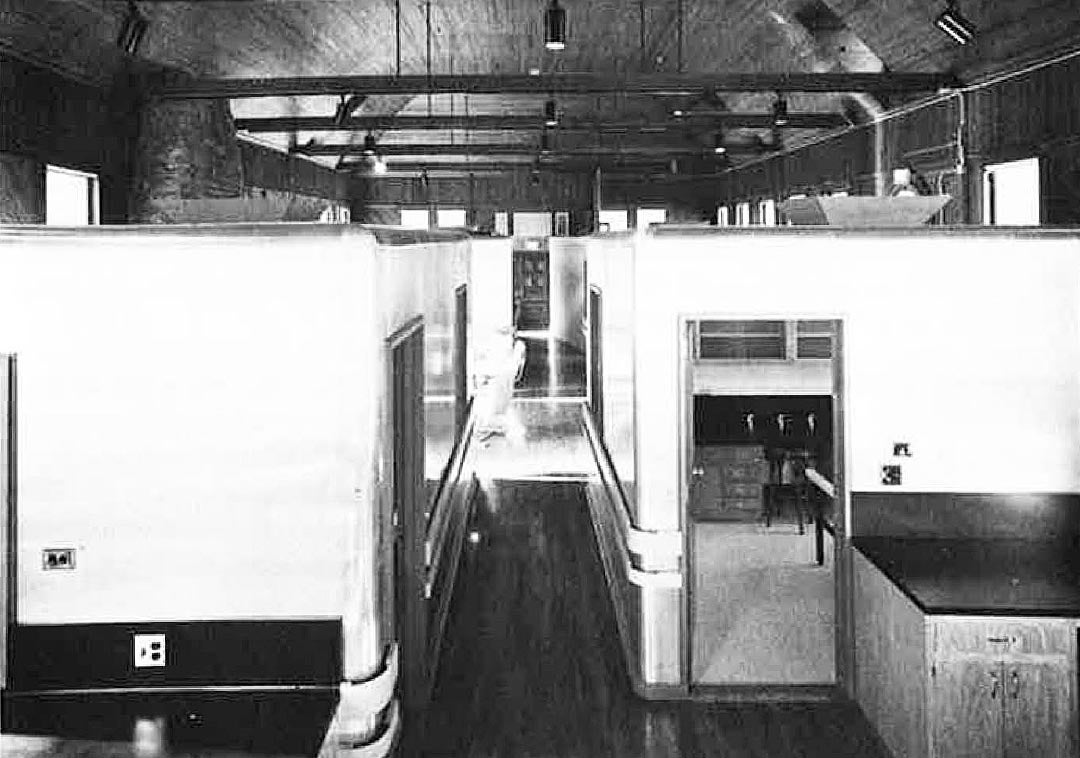
JDW had begun looking for funds for neuroscience research as early as 1969 and success came in 1971 with a grant of from the Alfred P. Sloan Foundation. This was used to support the neuroscience courses, but it was not sufficient to support a year-round research program. A step forward was taken when, with monies from the Robertson Research Fund, Jones Laboratory, which for many years had been used bacterial genetics research, was converted for neuroscience research. Then, in 1975, JDW reported:
“A prime factor in our move towards year-round research on nerve cells will be the newly created Marie Robertson Fund for Neurobiology, a marvelous new gift from the Robertson family of Lloyd Harbor.”
The Marie Robertson Fund for Neurobiology (MRRF) was an annual gift from the Banbury Fund, the Robertsons’ philanthropic body. It was used immediately to purchase equipment to make Jones Laboratory a first-class facility for neuroscience experiments. However, while major funding for year-round research was still not forthcoming, CSHL was becoming a force in neurobiology research through its courses. By 1978, the MRRF was helping support no fewer than 11 courses and workshops in neuroscience and JDW was able to declare that CSHL “…offered the world’s most advanced program of neurobiology training.” It was in 1978 that Charlie Robertson’s vision for neuroscience at CSHL was realized when Burgit Zipser was recruited as the first year-round researcher in neurobiology, and the following year “Neurobiology” had its own section in the Annual Report.
In 1979, large training grants from the National Institutes of Health and the National Science Foundation relieved some of the financial pressure on the courses program and it was decided to use some of the MRRF to support meetings on neuroscience at the Banbury Center. The first two were held in 1980, followed by a further eight, ending in 2013 (table 3).
The Robertson family has promoted neuroscience research at CSHL in a second way. Scientists spend far too much time writing grant applications to purchase equipment and materials for research, and to pay the salaries of themselves and members of their laboratory. In 1981, the Banbury Fund, the vehicle for the family’s philanthropy, provided $300,000 to endow the Charles and Marie Robertson Chair in Neuroscience, thus relieving the holders of the Chair of some of the burden of grant writing. Holders of the Chair include Holly Cline (1999-2008), Yi Zhong (2009) and Josh Huang (2010–present).
The Next Generation continues to provide invaluable support
The two endowments set up by Charles Robertson—the Robertson Research Fund and the Robertson Maintenance Fund—continue to provide invaluable support for CSHL. There are now three other independent Robertson family foundations derived from the Banbury Fund, the family’s main philanthropic entity: the Meier and Linnartz Family Foundation, the Charles and Marie Robertson Fund, and the Robertson Family Fund. These make annual contributions to Cold Spring Harbor Laboratory.
Robertson summed up his feelings about the family’s philanthropy to Cold Spring Harbor Laboratory in an April 15, 1973 letter to his daughter, Anne:
“I would like to think that mother approves of our choice of the Cold Spring Harbor Laboratory as a vehicle by means of which we propose to aid mankind through basic research to solve such problems as …cancer, the hereditary diseases of mankind, the mental illnesses, and disorders of the nervous system. There are scientists who believe that “molecular biology provides the closest insight man has yet obtained of the nature of life—and therefore of himself.” Then, too, there are those who feel that continued progress in the field of neurobiology will result in untold benefits to man. The Laboratory is sponsoring research in both of these areas. Accordingly, I do feel that in supporting the Laboratory through the good offices of the Robertson Research Fund we will be honoring the memory of a lady—exceedingly dear and close to us all.”
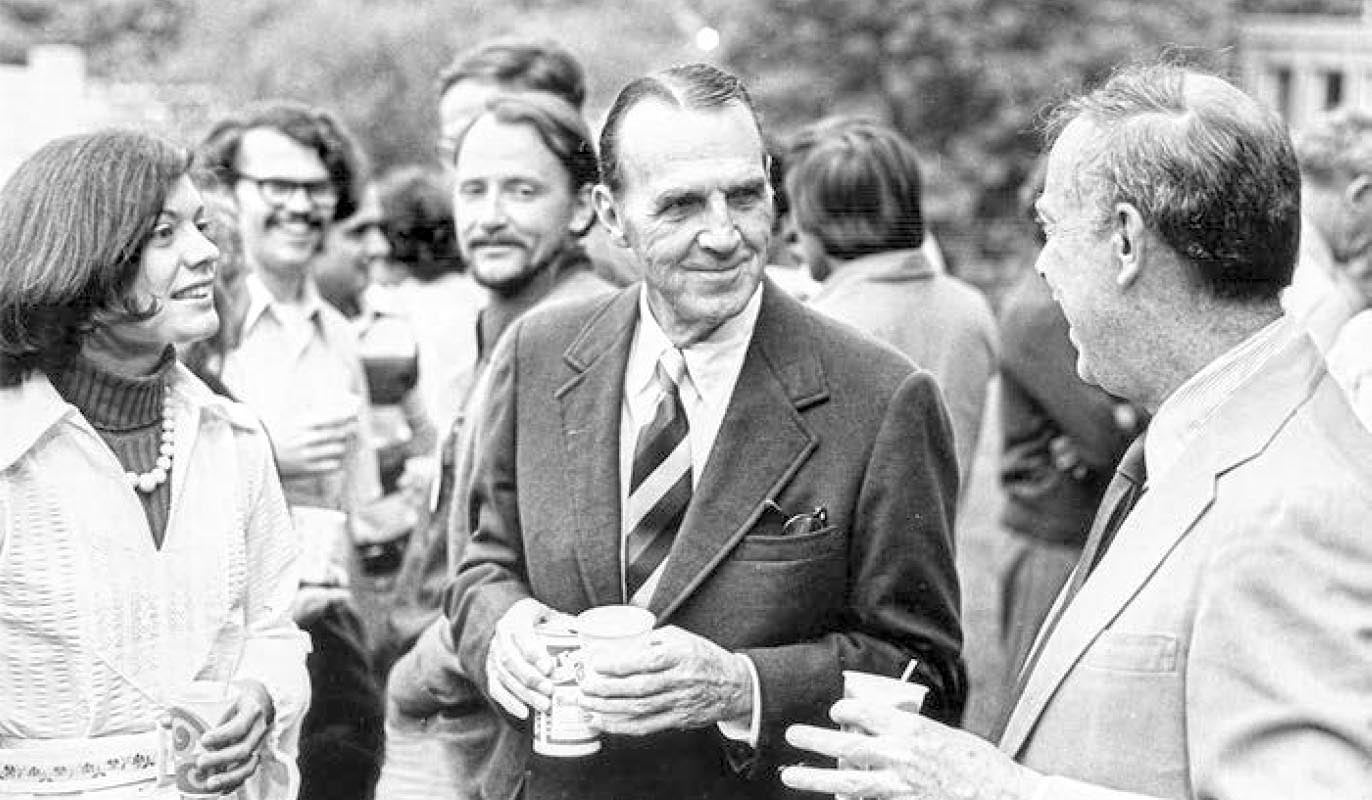
It is no exaggeration to say that the Robertson family gifts provided the foundation of the modern Cold Spring Harbor Laboratory and enabled its continuing success. The Robertson family’s great gift that established the Robertson Research Fund ensured that CSHL would survive the financial crises of the 1960s and 1970s, and enabled its scientists to do research of the highest caliber. The gift of the Robertson estate and the creation of the Banbury Center enabled the Laboratory to promote and stimulate research far beyond the shores of Long Island.
On Robertson’s death in 1981, Watson wrote in tribute to him:
“In all his dealings with me and other members of the Laboratory, Charles S. Robertson was the perfect benefactor, modest, yet highly intelligent and desirous of further learning, gracious, serious, but always with a sense of humor, and deeply loving and loyal to those individuals and institutions that he admired. His coming into our lives was a marvelous, unexpected gift, his delight and interest in the programs he helped make possible was a joy, and his passing this spring an occasion of deep sadness and reverence.”
Robertson summed up his feelings about the family’s philanthropy to Cold Spring Harbor Laboratory in an April 15, 1973, letter to his daughter, Anne:
“I would like to think that mother approves of our choice of the Cold Spring Harbor Laboratory as a vehicle by means of which we propose to aid mankind through basic research to solve such problems as… cancer, the hereditary diseases of mankind, the mental illnesses, and disorders of the nervous system. There are scientists who believe that “molecular biology provides the closest insight man has yet obtained of the nature of life—and therefore of himself.” Then, too, there are those who feel that continued progress in the field of neurobiology will result in untold benefits to man. The Laboratory is sponsoring research in both of these areas. Accordingly, I do feel that in supporting the Laboratory through the good offices of the Robertson Research Fund we will be honoring the memory of a lady—exceedingly dear and close to us all—Marie Hoffman Robertson.”
Bruce Stillman, who in 1994 became director and later President and CEO of Cold Spring Harbor Laboratory, reflects on the impact of Charlie Robertson’s beneficence:
“It is no exaggeration to say that the Robertson family gifts provided the foundation of the modern Cold Spring Harbor Laboratory and enables its continuing success. The Robertson family’s great gift that established the Robertson Research Fund ensured that CSHL would survive the financial crises of the 1960s and continues to provide the means for our scientists to do research of the highest caliber. Moreover, the gift of the Robertson estate and the creation of the Banbury Center enables the Laboratory to promote and stimulate research and policy far beyond the shores of Long Island.”
On Robertson’s death in 1981, Watson wrote in tribute to him:
“In all his dealings with me and other members of the Laboratory, Charles S. Robertson was the perfect benefactor, modest, yet highly intelligent and desirous of further learning, gracious serious, but always with a sense of humor, and deeply loving and loyal to those individuals and institutions that he admired. His coming into our lives was a marvelous, unexpected gift, his delight and interest in the programs he helped make possible was a joy, and his passing this spring an occasion of deep sadness and reverence.”
Table 1: Members of the first Robertson Research Fund Board
Table 2: A selection of notable Banbury Center meetings
Table 3: Banbury Center neuroscience meetings supported by the Marie Robertson Research Fund
| wdt_ID | Year | Title | Organizers |
|---|---|---|---|
| 1 | 1980 | Lessons From The Study of Molluscan Nerve Cells | C. F. Stevens E. R. Kandel |
| 2 | 1980 | Usage of Monoclonal Antibodies in Neurobiology | R. McKay M. Raff L. F. Reichardt |
| 3 | 1981 | Neurobiology of the Leech | J. Nicholls K. Muller G. Stent |
| 4 | 1996 | Genetic Approaches to Learning and Memory | E. R. Kandel A. Silva S. Tonegawa |
| 5 | 2000 | Structure, Mechanism, and Function of CaMKII | H. Cline J. E. Lisman |
| 6 | 2005 | Epilepsy Genetics and Pharmacogenetics | Z. Josh Huang G. Buzsaki |
| 7 | 2006 | The Phenomenology of Reconsolidation | Y. Dudai B. Everitt K. Nader |
| 8 | 2010 | The Role of the Habenula | B. Li F. Henn |
| 9 | 2011 | Evolution of Neural Circuits and Behavior | K. Honegger S. Shea |
| 10 | 2013 | Transposable Elements in the Brain and other Tissues | Joshua Dubnau Fred Gage |
Written by: Jan Witkowski, SBS Professor | publicaffairs@cshl.edu | 516-367-8455
